It quickly became evident that this five-day sea kayaking trip to Glacier Bay National Park's McBride Glacier was going to be different. It was twilight on Day One when we pulled into Nunatak Cove searching for a campsite. We spotted a large moose wading in the shallows that ambled away as we paddled closer to shore. Then, as we glided even closer, we realized a nearby large dark mass was a brown bear. Looking like a fur-covered Richard III, it stood, shook its humpy back, and slumped off into the brush.
We scouted other campsites, but the moose and bear had picked well. We went back, beached our kayaks, unloaded our gear, pitched our tents and, after a quick snack, slid into our sleeping bags. If the bear or the moose returned, none of us heard them.
“Judging by how comfortable these rocks are, I’m going to sleep good.” - Randy Boverman
| |
|
|
| |
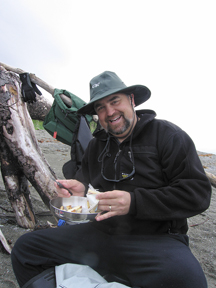 |
|
| |
Randy Boverman |
|
Years earlier I'd taken a day-long Glacier Bay cruise. The day was sunny, the wildlife abundant. But when the ship stopped to unload a group of kayakers leaving on a multi-day paddle, I wanted to be with them. So, when the chance came for me to join a paddling group, I grabbed it. Glacier Bay has no roads, so seeing the sights is possible only by cruise ships, tour boats or kayaks. Few visitors view Glacier Bay from "see" level. Most kayakers are day-paddlers. Depending on tides and weather, there are lots of excellent choices, including the Beardslee Islands.
| |
|
|
| |
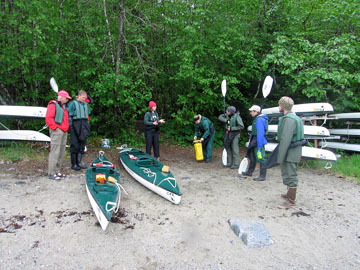 |
|
| |
Learning the basics |
|
After a night at Glacier Bay Lodge at Bartlett Cove, the main visitor area, Randy Boverman, a photographer friend, and I joined a morning class for day paddlers. After class - people without experience seem to learn quickly - we toured along the shoreline getting familiar with our two-person kayak and with each other.
| |
|
|
|
|
| |
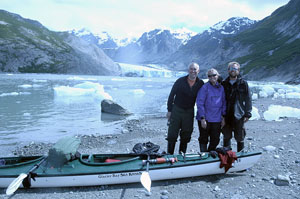 |
|
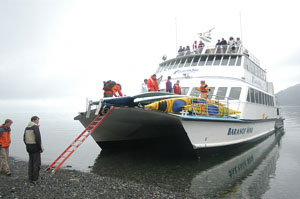 |
|
| |
Meet the family |
|
Unloading kayaks at Sebree Island |
|
That night we met with the other trip members – Wyatt Stahl, who was making his 13th Glacier Bay paddle, and his nephew, Adam Headrick, and niece Sara Headrick. The next morning we debarked the tour boat at Sebree Island, about 35 miles north of Bartlett Cove. Wyatt had studied tide charts to time our passages across open water. Rising tides propelled our three-kayak fleet. After two hours we beached at Muir Point, where we ate an early dinner, watched shore lounging bald eagles, hiked and napped. We took our time because the outgoing tides would have left us paddling as helplessly as gerbils running on a treadmill. We covered about 17 miles that first day.
| |
|
|
|
|
| |
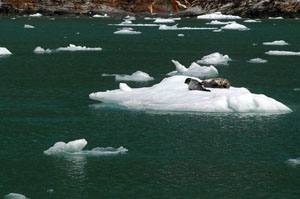 |
|
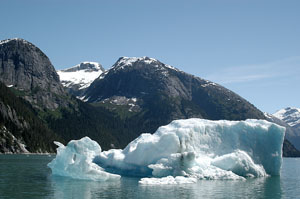 |
|
| |
McBride Lagoon |
|
Floating bergs |
|
The next morning we paddled the final two hours to McBride lagoon, within sight of McBride Glacier. In the lagoon we maneuvered through a gauntlet of huge ice cubes, actually small icebergs, to our camp. Some bergs were as clear as cocktail ice, many were peppered with accumulations of sand and gravel. Minutes after arriving, an explosion detonated water, snow and ice skyward as a giant slab of the McBride's front wall calved. More minutes later, waves high enough to surf slammed and flooded the shore, beaching bergs as big as buildings. Even from camp, probably about a mile from the glacier’s snout, we could see its aqua blue colors, areas where the calving exposed new sections of the glacier.
“Now I know what it feels like to be an olive in a drink” – Wyatt Stahl
| |
|
|
| |
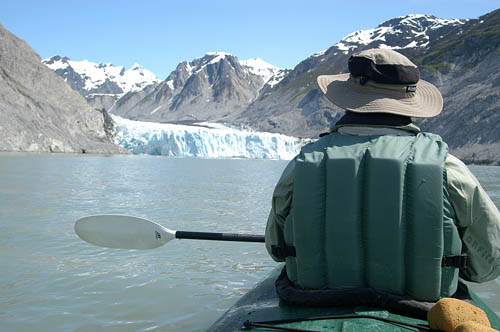 |
|
| |
View from the second seat |
|
See level takes on a new meaning from a sea kayak. Whether paddling near Bartlett Cove for the day or taking a multi-day trip, traveling at water level creates an intimacy not experienced from tour boats or cruise ships. It’s also possible to paddle into inlets and bays that larger vessels can't negotiate.
| |
|
|
|
|
| |
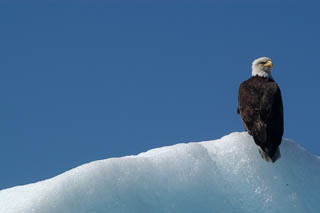 |
|
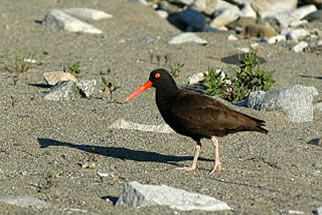 |
|
| |
Bald eagle perched on ice |
|
Oystercatcher |
|
It’s especially exhilarating to see a glacier calve from a kayak. It's required that kayakers be at least a quarter-mile distant because of waves and "shooters," pieces of ice that slip underwater before exploding up. Calving is a natural light-and-sound show, but there’s also quiet joy seeing and hearing flocks of birds cruising just above the water, drifting up to bald eagles poised like portraits on bergs or simply listening to the sounds of silence.
| |
|
|
|
|
| |
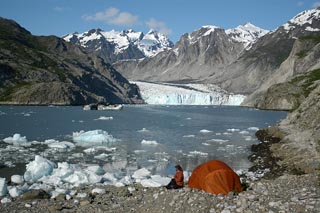 |
|
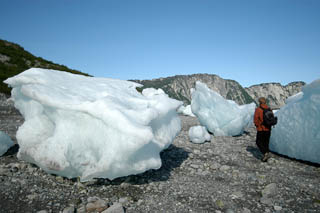 |
|
| |
Tent overlooking McBride Glacier |
|
Stranded berg |
|
Actually, it was seldom totally silent, especially at our McBride campsite. Bergs stranded by low tides in the lagoon or on shore continually snapped-crackled-popped. The dynamite sound of calvings magnified because it ricocheted off the White Thunder Ridge. After calvings, flocks of nesting killiwigs chattered excitedly because the turbulent water exposes sweet-tasting bugs and insects.
We watched mother harbor seals with young pups riding on passing bergs. Along the shore were black oystercatchers, which blurt out sharp whistles if people venture too close. Thrushes shrieked like referee whistles. While paddling we were treated to low-flying flights of puffins, called punk rocker birds because of their tufts of hair, and pigeon guillomets, their flapping wings sounding like rice paper clattering in the wind.
"This is better than any day I could have dreamed of.” - Wyatt.
| |
|
|
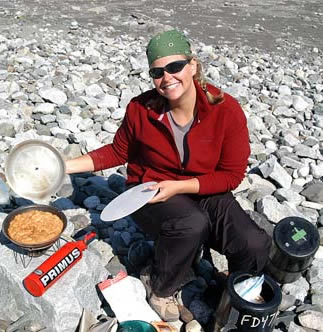 |
|
| |
What a view |
|
Fixing dinner |
|
I’m not sure if we ate to feed our paddle-induced hunger, or paddled like wind-driven whirligigs to work up an appetite. Wyatt repeatedly produced incredible meals – fry bread, dumplings, puddings, pasta with tasty sauces, sausages, cups of fresh-brewed coffee, glasses of wine.
| |
We fed our tummies at meals, and our souls while paddling. One afternoon we glided our kayaks within a quarter-mile of the glacier, which rises about 85 feet above the water and is a third-of-a-mile wide. It constantly reshaped itself as it slowly withdrew. Up close, the frozen mishmash of snow is tormented and fractured, with cave-like cuts in its base, and distinct sets of high tide lines. |
|
| |
|
|
| |
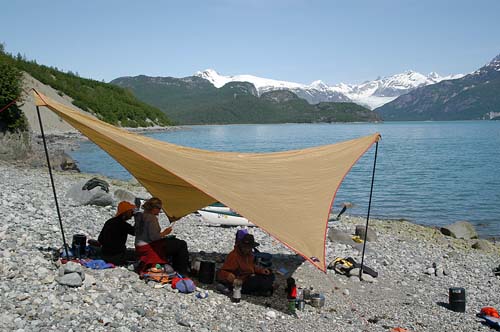 |
|
| |
Hiding from the sun |
|
We soaked in warm and sunny days. The day we paddled and rode full-moon extreme tides back to Sebree Island, I sometimes spun our kayak in a circle, reveling in the 360-degree view of snow-capped mountains, including the sparkling Fairweather Mountains and the striped Casement Glacier. Instead of using a tarp as shelter from rain, it was raised on poles to provide shade from the sun. Wyatt and Adam dove into the bay from rocks. Sarah, Randy and I slipped in for quick shivery swims.
Earlier that day, we had been too lax, dilly-dallying at camp and paddling out the lagoon just as the tide turned against us. It spun our kayaks in dizzy circles until we paddled close to shore and stroked furiously. We reached the inlet just before the speeding tide washed us back inside.
“My shoulders are beginning to burn.” – Adam.
“Well, there’s ice packs everywhere.” – Wyatt.
| |
|
|
| |
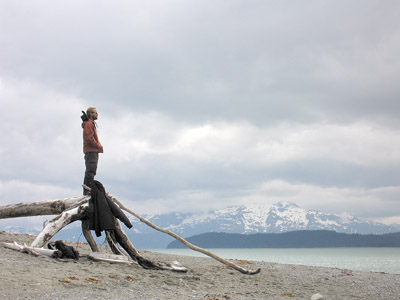 |
|
| |
Looking back |
|
We fed kayaks up to the deck of the tour boat, where they were stacked and tied down, then clambered up the ladder. The next few hours we completed the Glacier Bay circuit, by itself a glorious trip. That afternoon we flew back to Juneau, where we headed our separate ways.
I had dreamed of this trip, but never imagined that Glacier Bay’s ruggedly raw beauty could be so visually and physically involving, especially from a “see” kayak.
When You Go
Glacier Bay National Park and Preserve: (907) 697-2230; www.nps.gov/glba
General Information: For information on lodging, dining and bay tours contact Glacier Bay Lodge & Tours (888) 229-8687; www.visitglacierbay.com
For information on kayak rentals contact Glacier Bay Sea Kayaks (907) 697-3002 June 1 to September 30 or (907) 697-2414 October 1 to May 31; www.glacierbayseakayaks.com
For information on guided kayak trips contact Alaska Discovery (800) 586-1911; www.alaskadiscovery.com.
Concession services are offered mid-May through September.
| |
About the author |
|
|
|
|
Lee Juillerat is a writer-photographer in Klamath Falls, Oregon. He is also a frequent contributor to various magazines, including Northwest Travel, where this originally appeared. He can be contacted at [email protected]. |
|
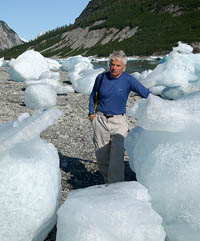 |
|
| |
|
|
Lee, living the dream |
|
|

